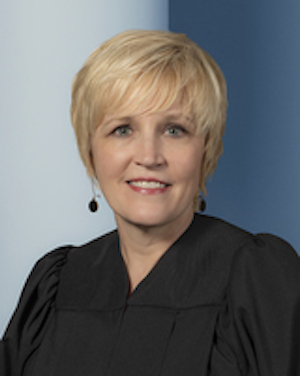Less than nineteen months after being appointed to the Iowa Supreme Court, Susan Christensen is now that body’s chief justice. Justice David Wiggins had served as acting leader on the high court since the unexpected passing of Chief Justice Mark Cady in November.
When Governor Kim Reynolds, Republican lawmakers, and one or more Supreme Court justices schemed last year to end Cady’s term early, Justice Thomas Waterman was widely seen as the chief-in-waiting. However, by the time Reynolds appointed Cady’s replacement, Dana Oxley, in late January, multiple sources indicated Waterman was no longer interested in the job. The seven justices elected Christensen on February 24.
It’s been many years since a justice has risen so quickly to the Iowa Supreme Court’s most senior position.
The Iowa Judicial Branch has posted short biographies of all past Supreme Court justices. During the 19th century, several justices served as chief after only a few years on the court. For much of the 20th century, the chief justice position rotated frequently, and a number of justices served in that capacity for only six months to a few years.
The court lengthened the chief justice’s term in 1959. The first “permanent” chief justice was Robert Larson, who had previously filled several shorter terms as chief during his six years on the Supreme Court.
Theodore Garfield was chief justice “on a continuing basis” from 1961 until his mandatory retirement in 1969. He left the bench as Iowa’s longest-serving Supreme Court justice, having joined the court in 1941. (Jerry Larson, Chief Justice Christensen’s father, surpassed that record; his tenure on the high court lasted from 1978 to 2008.)
C. Edwin Moore had about seven and a half years on the high court under his belt before becoming chief justice, a position he held from 1969 to 1978. His successor W. Ward Reynoldson likewise had been an associate justice for seven years before colleagues made him chief justice from 1978 to 1987.
Arthur A. McGiverin joined the Supreme Court in 1978 after thirteen years as a District Court judge. He served as chief justice from 1987 to 2000. Louis Lavorato was the next chief; he had been an associate justice for fourteen years prior to 2000.
Iowa justices elected the high court’s first woman chief in 2006. Marsha Ternus had been appointed to the Supreme Court thirteen years earlier. Her service was curtailed by Iowa voters in a backlash against the Varnum v Brien marriage equality ruling in 2010.
Cady was chosen to succeed Ternus in 2011, thirteen years after he joined the Supreme Court. He won his colleagues’ vote of confidence again after being retained in 2016. What should have been an eight-year term as chief was reduced by the state law Republicans enacted last year. Cady unfortunately did not live to serve out his shortened term.
I enclose below the Iowa Judicial Branch news release with more background on the new chief. Christensen will be up for retention on the November 2020 ballot, along with Justice Christopher McDonald, whom Reynolds appointed last year, and Justices Waterman and Edward Mansfield, assuming they want to continue in their current positions. Governor Terry Branstad appointed Waterman and Mansfield in 2011; Iowans voted to retain them the following year.
Des Moines, Iowa, February 24, 2020—The Iowa Supreme Court has selected Justice Susan Christensen, Harlan, as its next chief justice. Justice Christensen will succeed Chief Justice Mark Cady who passed away suddenly November 15, 2019. Justice David Wiggins has served as acting chief justice since Chief Justice Cady’s passing. Justice Christensen will be the second woman to serve as chief justice of Iowa’s highest court.
“I am honored to be selected by my colleagues as chief justice of the Iowa Supreme Court,” Chief Justice Christensen said. “Three months ago, our court faced a sudden crisis with the unexpected death of Chief Justice Cady. I am deeply appreciative of the immediate leadership by acting Chief Justice David Wiggins. He provided the stability to push forward with the court’s work while the judicial branch and entire state grieved for the Cady family. As chief justice, I will maintain my passion for child welfare and juvenile justice and do my best to lead Iowa’s judiciary in a manner which provides all 99 counties with fair and impartial justice.”
In addition to judicial duties and writing opinions, the chief justice presides over oral arguments and court conferences, sets the court’s oral argument schedule, and delivers the state of the judiciary address to the legislature each January. As administrative head of the Iowa Judicial Branch, the chief justice presides over the judicial council and works with the state court administrator to manage judicial branch operations with a FY 2020 appropriation of $181 million, 334 judicial officers, and more than 1,700 employees in all 99 counties. The chief justice also appoints members to supreme court committees and task forces to propose policies and rules of procedure and practice.
Chief Justice Christensen was appointed to the Iowa Supreme Court in 2018 by Governor Reynolds. She will be up for retention in November 2020. Prior to her appointment to the supreme court, Chief Justice Christensen was appointed a district associate judge in 2007 and a district court judge in 2015. Before becoming a judge, she practiced law in Harlan for 16 years. Chief Justice Christensen currently chairs the Children’s Justice State Council as well as the Family First Task Force. She previously served on the Supreme Court’s Family Law Pro Se Forms Committee, Child Support Guidelines Review Committee, and Parents Representation Standards Committee. She is a member of The Iowa State Bar Association, the Southwest Iowa Bar Association, and the Shelby County Bar Association.
Chief Justice Christensen was born and raised in Harlan, Iowa. She earned her bachelor’s degree from Judson College in 1988 and her law degree from Creighton University School of Law in 1991. She is married with five children and five grandchildren.

